Archive for January, 2013

January 10, 2013
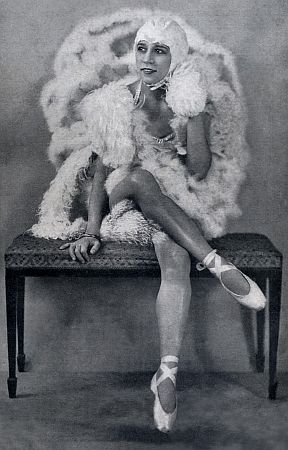
Germaine Mitty (otherwise Mitti) (fl. 1920s),
French actress, singer and dancer
(photo: Foulsham & Banfield, London, 1921)
Germaine Mitty to appear in the Ziegfeld Follies of 1921, Globe Theatre, New York ‘Germaine Mitty, the sensational Parisian musical comedy actress, used to prove to her Parisian audiences that her costume could be hidden in the palm of her hand. She removed it on the stage and showed them how it was done. She will be the principal attraction in the new Ziegfeld follies show and New Yorkers are wondering if she is going to show them, too.’
(The Fort Wayne News and Sentinel, Fort Wayne, Indiana, Monday, 30 May 1921, p. 6d)
Posted in Uncategorized | Tagged Foulsham & Banfield (photographers), Germaine Mitti, Germaine Mitty, Globe Theatre (New York), Ziegfeld Follies (1921) | Leave a Comment »

January 10, 2013
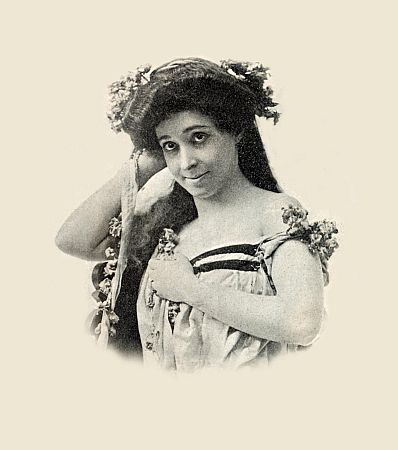
Lucia Nola (fl. late 19th/early 20th Century),
American soprano
(photo: Baker Art Gallery, Columbus, Ohio, circa 1905)
Lucia Nola, a soprano from Washington, D.C., has joined the Roscian Opera Company, 1905
‘Miss Lucia Nola, who was for some years prominently identified with the local singers as a soprano, is now with the Roscian Opera Company as prima donna soprano. The operas being given by the company are Sousa’s El Capitan, Gilbert and Sullivan’s Mikado, Balfe’s Bohemian Girl, [Robert Planquette’s] Chimes of Normandy [i.e. Les Cloches de Corneville], and [Victor Herbert’s] The Serenade which the Bostonians made famous. Miss Nola is heard in all the leading roles. She has hots of friends in this city, who will be interested to known of her success. Her work in Washington was characterized by a large amount of charitable work, such as the singing in the hospitals and the jail, and she did much other philanthropic work. She was a prominent and active member of the Doubleday Sunday Night Club.’
(The Washington Post, Washington, D.C., Sunday, 15 October 1905, Part Two, Editorial Section, p. 10a)
Posted in Uncategorized | Tagged Baker Art Gallery (photographers), Doubleday Sunday Night Club, El Capitan (operetta), Gilbert and Sullivan, John Philip Sousa, Les Cloches de Corneville, Lucia Nola, Michael William Balfe, Robert Planquette, Roscian Opera Company, The Bohemian Girl (opera), The Bostonians, The Chimes of Normandy (opera), The Mikado (comic opera), The Serenade (operetta), Victor Herbert | Leave a Comment »

January 10, 2013
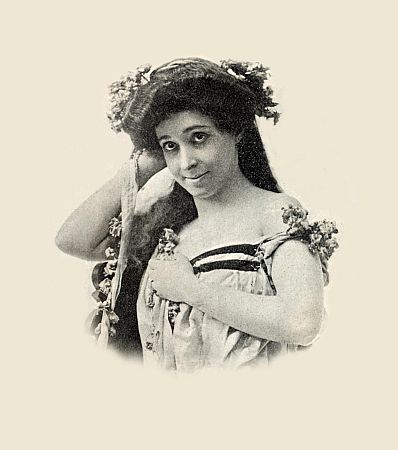
Lucia Nola (fl. late 19th/early 20th Century),
American soprano
(photo: Baker Art Gallery, Columbus, Ohio, circa 1905)
Lucia Nola, a soprano from Washington, D.C., has joined the Roscian Opera Company, 1905
‘Miss Lucia Nola, who was for some years prominently identified with the local singers as a soprano, is now with the Roscian Opera Company as prima donna soprano. The operas being given by the company are Sousa’s El Capitan, Gilbert and Sullivan’s Mikado, Balfe’s Bohemian Girl, [Robert Planquette’s] Chimes of Normandy [i.e. Les Cloches de Corneville], and [Victor Herbert’s] The Serenade which the Bostonians made famous. Miss Nola is heard in all the leading roles. She has hots of friends in this city, who will be interested to known of her success. Her work in Washington was characterized by a large amount of charitable work, such as the singing in the hospitals and the jail, and she did much other philanthropic work. She was a prominent and active member of the Doubleday Sunday Night Club.’
(The Washington Post, Washington, D.C., Sunday, 15 October 1905, Part Two, Editorial Section, p. 10a)
Posted in Uncategorized | Tagged Baker Art Gallery (photographers), Doubleday Sunday Night Club, El Capitan (operetta), Gilbert and Sullivan, John Philip Sousa, Les Cloches de Corneville, Lucia Nola, Michael William Balfe, Robert Planquette, Roscian Opera Company, The Bohemian Girl (opera), The Bostonians, The Chimes of Normandy (opera), The Mikado (comic opera), The Serenade (operetta), Victor Herbert | Leave a Comment »
 January 10, 2013
January 10, 2013
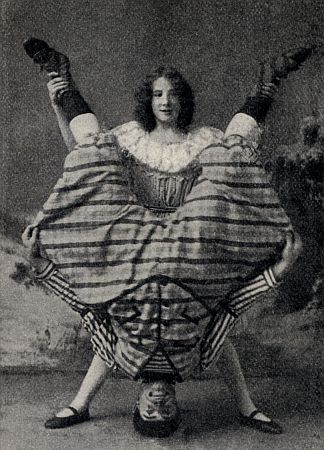
The Vedmars (fl. early 20th Century), comedy acrobats
(photo: unknown, circa 1905)
The Vedmars on tour in the United States with Watson’s Americans burlesque company, March 1903
‘Watson’s Americans, which will be the attraction at the Gaiety for the first three days of next week, is one of the largest and oldest burlesque companies on the road. The management have spared neither time nor money to get the best talent in the profession this season. This large organization consists of 35 people. The company is headed by the versatile artists, Jeanette Dupre and W.B. Watson. Among the other artists are ”Selbini,” the phenomenal trick cyclist and juggler. This act alone is well worth the price you pay for admission. The Vedmars are direct from the music halls of London, which is a sufficient guarantee of their worth. Ella Shields, the phenomenal baritone; West and Williams, Hayman and Hayman, Batchellor Sisters, Burke and Raymond, and many others. Mr. Watson is producing the farce of Levy in Japan by request of different managers. This farce was a howling success last season. It introduces all members of the company.’
(The Albany Evening Journal, Albany, New York, Saturday, 21 March 1903, p. 6g)
‘The name sounds Hindoo, but the pose is Greek. The Vedmars, Renee and Bert, are, needless to say, lights of the vaudeville stage. There ”stunt” has a few original touches in it and is worth staying for, even if it’s after a musical act.’
(The Standard and Vanity Fair, New York, Friday, 16 February 1906, [p. 4])
Posted in Uncategorized | Tagged acrobats, Batchellor Sisters, Bert Vedmar, Burke and Raymond, Ella Shields, Gaiety Theatre (Albany), Hayman and Hayman, Jeanette Dupre, Levy in Japan (farce), Renee Vedmar, Selbini (trick cyclist and juggler), The Vedmars, vaudeville, W.B. Watson, Watson's American Burlesque Company, West and Williams | Leave a Comment »
 January 9, 2013
January 9, 2013
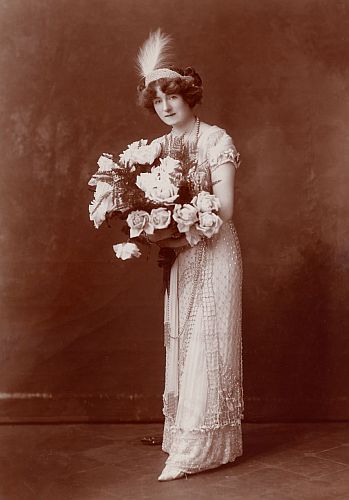
Daisy Le Hay (b. 1883), English actress and singer,
as she appeared during 1910/11 in the United States’ touring production of
The Dollar Princess as Alice Cowder, a part originated on the
English-speaking stage by Adrienne Augarde at the Knickerbocker, New York, 6 August 1909,
and by Lily Elsie at Daly’s, London, 25 September 1909.
(photo: Moffett, Chicago, 1910)
‘Daisy Le Hay is the Alice. She plays the part with fire, and has a voice that will keep her in the front rank of musical comedy artists. She sang the songs allotted to her with a resonance and quality of tone that were delightful.’
(The Washington Post, Washington, D.C., Tuesday, 21 March 1911, p.5b)
Lillian Russell and Daisy Le Hay, who are appearing in Chicago, model their dresses at a dressmakers’ convention, 1910
‘Actresses set the fashion in dress for America. So insisted Mrs. Idah McGlone Gibson in the address she delivered at the dressmakers’ convention. And the reason therefor is that actresses ”dress the part.” their dresses always are en rapport with the character they seek to portray.
”’For that same reason the fashionably dressed woman must choose a gown indicative of her own temperament,” said Mrs. Gibson. ”The best dressed actresses of the stage choose gowns that exactly fit their own personalities.”
‘Just at that moment a velvet curtain cutting off a portion of the stage was drawn aside and in the glare of the lights appears Miss Lillian Russell, her daughter, Mrs. Dunsmore, and Miss Daisy Le Hay, actresses appearing now in the Chicago theatres.
”’No woman in America has spent more money in the American dress shops than Miss Russell,” said Mrs. Gibson, after she had introduced the actresses and each had performed a bewitching smile for the benefit of the audience of dressmakers.
‘Then she pointed out that the dress worn by Miss Russell was just the sort that should be affected by the sort of woman Miss Russell is. Miss Daisy Le Hay was attired in a frock of another character in perfect consonance with her individual type of figure.
‘Then Mrs. Gibson proceeded to hammer home the philosophy of perfect gown wearing.’
(New Castle News, New Castle, Pennsylvania, Friday, 30 September 1910, p.9b)
Posted in Uncategorized | Tagged Adrienne Augarde, Daisy Le Hay, Daly's Theatre (London), Knickerbocker Theatre (New York), Lillian Russell, Lily Elsie, Moffett (photographers), Mrs Dunsmore, Mrs. Idah McGlone Gibson, The Dollar Princess (musical play) | Leave a Comment »

January 9, 2013

Zena Dare (1887-1975), English actress,
as the Hon. Betty Silverthorne and chorus singing
‘The Sea-Pink and the Nautilus’ in The Beauty of Bath,
Aldwych Theatre, London, late Summer 1906
And the sea-pinks softly whispered to the nautilus –
Our lot till now has been so hard and perilous,
We’d like to shelter, if we dare,
In the meshes of your silv’ry hair;
And we want to find a sole to quickly marry us.
So spread you silken sail and swiftly carry us
Far across the blue Atlantic,
For delay will drive us frantic,
Sail away you pretty nautilus,
You pretty nauti-nauti-nauti-lus!
(photo: Bassano, London, 1906)
The Beauty of Bath, a musical play by Seymour Hicks and Cosmo Hamilton, with music by Herbert E. Baines and lyrics by Charles H. Taylor, was first produced at the Aldwych Theatre, London, on 19 March 1906. The starring roles of Lieut. Richard Alington and the Hon. Betty Silverthorne were played respectively by Seymour Hicks and his wife, Ellaline Terriss. During their Summer holiday that year these parts were played by Hicks’s brother, Stanley Brett, and Zena Dare. The latter was assigned an interpolated song, ‘The Sea-Pink and the Nautilus.’
Posted in Uncategorized | Tagged 'The Sea-Pink and the Nautilus' (song), Aldwych Theatre (London), Bassano (photographers), Charles H. Taylor, Cosmo Hamilton, Ellaline Terriss, Herbert E. Baines, Seymour Hicks, Stanley Brett, The Beauty of Bath (musical comedy), Zena Dare | Leave a Comment »

January 9, 2013

Madge Rossell (fl. late 19th/early 20th Century),
English actress/chorus girl
(photo: unknown, circa 1895)
This halftone cigarette card of Madge Rossell was issued with Ogden’s Midnight Flake tobacco during the mid 1890s. Although little is known about Miss Rossell, she is recorded as having appeared in small parts in various musical plays, including An Artist’s Model (Daly’s, London, 18 September 1895), A Modern Don Quixote (Lyric, London, 21 May 1898), A Greek Slave (Daly’s, London, 8 June 1898), and Hidenseek; or, The Romance of a Ring, Globe, London, 10 December 1901).
Posted in Uncategorized | Tagged A Greek Slave (musical comedy), A Modern Don Quixote (musical farce), An Artist's Model (musical comedy), cigarett card, Daly's Theatre (London), Globe Theatre (London), Hidenseek; or The Roamance of a Ring (musical play), Lyric Theatre (London), Madge Rossell, Ogden's Midnight Flake | Leave a Comment »

January 9, 2013
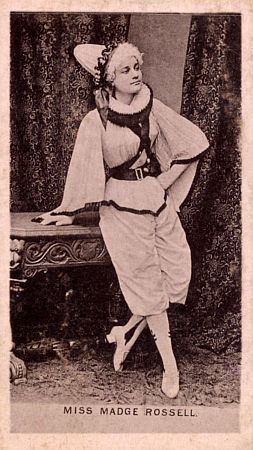
Madge Rossell (fl. late 19th/early 20th Century),
English actress/chorus girl
(photo: unknown, circa 1895)
This halftone cigarette card of Madge Rossell was issued with Ogden’s Midnight Flake tobacco during the mid 1890s. Although little is known about Miss Rossell, she is recorded as having appeared in small parts in various musical plays, including An Artist’s Model (Daly’s, London, 18 September 1895), A Modern Don Quixote (Lyric, London, 21 May 1898), A Greek Slave (Daly’s, London, 8 June 1898), and Hidenseek; or, The Romance of a Ring, Globe, London, 10 December 1901).
Posted in Uncategorized | Tagged A Greek Slave (musical comedy), A Modern Don Quixote (musical farce), An Artist's Model (musical comedy), cigarett card, Daly's Theatre (London), Globe Theatre (London), Hidenseek; or The Roamance of a Ring (musical play), Lyric Theatre (London), Madge Rossell, Ogden's Midnight Flake | Leave a Comment »
 January 9, 2013
January 9, 2013

Jessie Vokes (1851-1884), Victoria Vokes (1853-1894)
and Rosina Vokes (1854-1894), English actresses and dancers
(photo: Mora, New York, circa 1880)
‘JESSIE VOKES DEAD.
‘THE FIRST ONE TO DIE OF THE FAMOUS FAMILY OF COMEDIANS.
‘Miss Jessie Vokes, the actress, a member of the well-known Vokes family, died yesterday in London. She was educated to the stage from a tender age, and when only 4 years old appeared at the Surrey Theatre, where she played in children’s characters. In the early part of her career she played Mamillius in The Winter’s Tale; Prince Arthur in King John, and the Prince of Wales in Richard III. She attracted special notice first as one of the children in [Charles Reade and Tom Taylor’s comedy] Masks and Faces, dancing, with her sister, a jig, when old Benjamin Webster played Triplet at the London Standard Theatre. With her brothers and sisters, Fred and Fawdon and Victoria and Rosina, she began began her career as ”The Vokes Children,” which was afterward changed to ”The Vokes Family,” at the Operetta House in Edinburgh. Their success was pronounced and continuous. Their debut was made in London at the Lyceum Theatre on Dec. 26, 1868, in the pantomime of Humpty Dumpty, and they traveled through a great part of the civilized world. Jessie Vokes, the eldest of the sisters, was educated in the ”business” of the stage by Mr. Cheswick, and in dancing, in which she excelled, by Mr. Flexmore. The piece that most successfully carried an audience by storm was The Belles of the Kitchen, in which the ”family” made its debut in this country at the Union-Square Theatre on April 15, 1872. Jessie’s clever recitations and dancing were appreciated, but she was not so prominent in the cast as Victoria and Fred, who were especially happy in their rendering of the tower scene from Il Trovatore, or as Miss Rosina, who was regarded by the young men as the flower of the family.’
(The New York Times, New York, Friday, 8 August 1884, p. 5b)
Posted in Uncategorized | Tagged Benjamin Webster, Charles Reade, Cheswick (actor), Fawdon Vokes, Fred Vokes, Humpty Dumpty (pantomime), Il Trovatore (opera), Jessie Vokes, King John (tragedy), Lyceum Theatre (London), Masks and Faces (comedy), Mora (photographers), Operetta House (Edinburgh), Richard Flexmore, Richard III (tragedy), Rosina Vokes, Standard Theatre (London), Surrey Theatre (London), The Belles of the Kitchen (farce), The Winter's Tale (play), Tom Taylor, Union Square Theatre (New York), Victoria Vokes, Vokes Family | Leave a Comment »

January 9, 2013
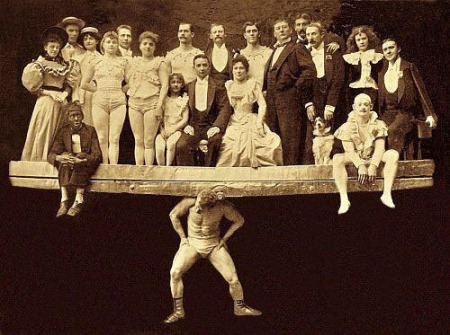
Eugen Sandow (1867-1925), Prussian born strongman, and company
(photo: unknown, USA, mid 1890s)
Sandow at the Empire Theatre, Birmingham, England, March, 1898
‘At the Empire this week Sandow, the man of muscle, is the star, and crowds of would-be Samsons have watched his performance in the hope perhaps of strengthening their own muscles by gazing at the remarkable development of those of the famous athlete. Sandow lifts a couple of dumb-bells, each weighing 90lb, with wonderful ease, and he also raises a 300lb bar-bell, lifting it above his head with one hand only. Lying down with his neck and feet resting on supports, he lifts two 56lb weights while four men stand on his body. The strength of his fingers is shown by the ease with which he tears up first one and then two, and three packs of playing cards, and if one would realise Browning’s line, ”The muscles all a-ripple on his back,” it is very easy to do so at the Empire this week.’
(The Owl, Birmingham, England, Friday, 4 March 1898, p. 1a)
Posted in Uncategorized | Tagged Empire Theatre (Birmingham), Eugen Sandow | Leave a Comment »










